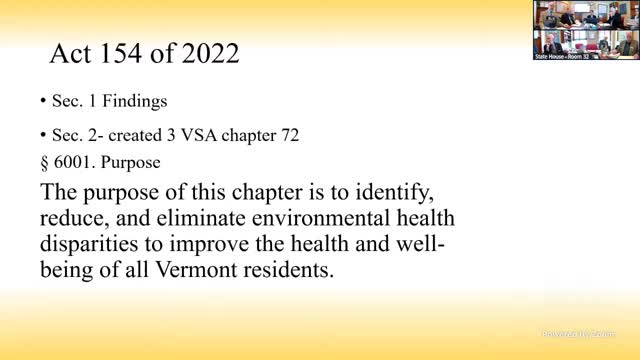
This article was created by AI using a video recording of the meeting. It summarizes the key points discussed, but for full details and context, please refer to the video of the full meeting. Link to Full Meeting
The heart of the discussion centered on three key concepts: environmental burdens, environmental benefits, and meaningful participation. These terms, foundational to the policy, were defined in detail, highlighting the state's commitment to fostering an inclusive approach to environmental decision-making. Environmental justice, as articulated in the policy, emphasizes equitable access to resources and fair treatment in the development and enforcement of environmental laws.
Lawmakers noted that Vermont's approach aligns closely with similar policies adopted by other states, reflecting a growing national recognition of the need for environmental equity. The policy seeks to address systemic issues such as structural racism and the marginalization of communities, particularly those identified as environmental justice-focused populations. This includes areas where median household incomes fall below 80% of the state average or where significant portions of the population identify as people of color or have limited English proficiency.
The meeting also underscored the importance of defining environmental benefits and burdens. Benefits encompass essential resources like clean air, water, and access to green spaces, while burdens refer to negative impacts such as pollution and inadequate infrastructure. By clearly delineating these terms, Vermont aims to create a framework that not only identifies but actively mitigates environmental disparities.
As the meeting progressed, the conversation shifted towards the practical implementation of this policy, including the mapping of affected communities to better understand and address their specific needs. Lawmakers expressed optimism about the potential for meaningful participation, ensuring that all individuals have a voice in environmental decision-making processes.
In conclusion, Vermont's environmental justice policy represents a significant commitment to equity in environmental governance. As the state moves forward, the focus will be on translating these principles into actionable strategies that empower communities and promote a healthier, more sustainable environment for all. The discussions from this meeting signal a crucial step towards a more inclusive future, where every Vermonter can participate in shaping the environmental landscape.
Converted from House Energy and Digital Infrastructure 2025-04-04 10:30am meeting on April 05, 2025
Link to Full Meeting
Comments
View full meeting
This article is based on a recent meeting—watch the full video and explore the complete transcript for deeper insights into the discussion.
View full meeting